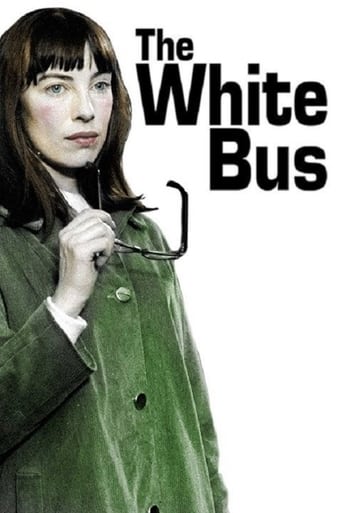ethelmalley
This review is for Red, White and Zero. It's possible to reconstruct the facts around this film, but the IMDb listing is confusing. Lindsay Anderson's The White Bus was briefly and unsuccessfully released with two other shorts: a very short film by Peter Brook featuring Zero Mostel in a hurry (The Ride of the Valkyries - lots of frantic mugging), and Red and Blue by Tony Richardson. Only Lindsay Anderson's film seems to be readily available. (The others would make good Criterion extras.)I saw Red, White and Zero on late night Australian television in 1984. The White Bus wasn't seen to best effect on the small screen - rather self-consciously poetic, but as an Anderson film it will obviously bear reseeing. Red and Blue was fascinating and not very good. Tony Richardson was in love with the Nouvelle Vague, and raided its box of tricks and its composers (Bassiak from Jules and Jim; Duhamel from Godard's Pierrot le Fou) in an imitation Demy/Moreau vehicle for Vanessa Redgrave! She fluted a song in English, and Kevin Brownlow provided the jumpcuts. (You can hear her singing Bassiak's Bonjour Papa on YouTube).Most weirdly, the sex interests for the romantically-besieged Vanessa were provided by Douglas Fairbanks Jr, William Sylvester (the scientist from Kubrick's 2001), and Michael York. The sparks didn't exactly fly. Anyway, after 30 years, it's time to make this available again.
Charles Herold (cherold)
Odd little movie in which some girl rides around on a tour bus. Nothing really happens. Some of the people here talk about wonderful performances, but really, there's the occasional brief conversation and a lot of touring. There are some cute moments, like some odd character going on about class distinctions, but mainly this just seems to have no point to it at all.Yet for some reason it has a lot of favorable reviews. And the only thing I can think of is that there are British people who recognize some of the sites and the sorts of people and it takes them back to that time or gives them that feeling of connection. But I've never been to England and to me this was just a huge waste of time.
sbwords
A strange, moody, yet captivating film that captures the atmosphere at a certain time in Britain. I love the images of the terrace houses, the back alleyways and bombed out areas. I grew up just off Holderness Road in Hull and the images gave me a flashback to that time. The air is heavy with coal smoke, the roads have few cars and kids are playing in the streets, whilst the people all look gray like in a Lowry painting. The silent parts are the best as the images speak for themselves.The humour is nicely understated. My particular favorite is the scene with the lift and the security guard.I not sure what messages the film is seeking to convey, but as an observation piece it is superb.
allenrogerj
An early film, originally meant to be part of a three part set of adaptations of stories by Shelagh Delaney, which was never finished, which has many of the techniques that Anderson later used in If and O lucky Man. A girl finishes work in an open-plan office of the type there used to be, walks past the hanging body of another girl (or perhaps her own body- the film could be an after-death fantasy) takes a train to a Northern town, latches onto a civic tour led by the mayor and has a bag of chips in a café. That's the story. What goes with it is Anderson's strange way of looking at what may be reality- when the girl is going to catch the train a young upper-class man makes a long speech at her, both declaring his love and arguing for class distinctions. All the girl says is "Goodbye". Again, there is no way of telling if the man is a fantasy of the girl's or- if he is "real" in the film's context- whether he is connected with the girl in any way. In the Northern town the girl gets on/is roped into a tour led by the mayor. The mayor- played by Arthur Lowe, one of Anderson's regular actors- is both absurd and dignified, presented dead-pan the mace bearer is a sinister character, making gnomic remarks, a messenger of death, perhaps; the passengers include Africans and Indians and they look round the town- an industrialist's estate left to the town where he made his wealth, a girls' school, a museum, a library... In the end the girl wanders off and sits in a chippie with a bag of chips as the owners clean up around her- a perfect cinematic koan, no longer than it need be.Afterword, two years later:I forgot some important aspects in my last review, or I saw a different version today: the girl says "I'll write", not "Goodbye" to the upper-class young man and i'd forgotten how deliberately the film slides in and out of different kinds of reality and how much it uses parody and cliché- the mayor's obsession with "mucky books" in the library, the painting of Jesus with a flock of wolves in the art gallery, the tableau of Le Dejeuner sur l'Herbe in the park, the industrial estate depicted as a meaningless mechanical hell with the visitors walking immune through its perils, the realistic scene of Civil Defence practise which ends with the whole party turned into literal dummies except the girl. Above all, though, I forgot the film's opening: a different girl on a tour boat going downriver through London, past Parliament, photographed with ritualistic care, past the Shell Building, through the City where the girl in the film works, which makes the whole main action even more distanced and derealised.



